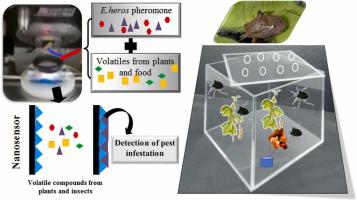Sensors and Actuators A: Physical ( IF 4.1 ) Pub Date : 2022-08-08 , DOI: 10.1016/j.sna.2022.113804 Janine Martinazzo , Maria Carolina Blassioli Moraes , Juliana Steffens , Clarice Steffens

|
This work aims to apply PANI.Ag cantilever nanosensor to detect volatiles from in vivo E. heros and interfering compounds. The stink bug insects were collected in crops and kept in an environment (chamber) that mimicked the soy culture. The study was carried out with male and female insects together and with male and female insects separated; with interfering compounds from stink bug Diceraeus furcatus; in addition, with synthetic compounds as tridecane and hexenyl (Z)− 3-acetate. The cantilever nanosensor exposed to the volatiles from males and females showed a reduction in the resonance frequency and did not show a response to the volatiles from the chamber that contained only food and water (without insects), and control (synthetic air). The response of the volatiles from the chamber containing female insects was similar to the chamber without insects and was very close to the control. In the chamber containing only males, a reduction in the resonance frequency resulted from the pheromone released by the insects. The resonance frequency did not change considerably when exposed to the volatiles from the environment with D. furcatus, when compared to the control, as well as to tridecane and hexenyl (Z)− 3-acetate compounds. Thus, the gas nanosensor was able to distinguish the volatile compounds released by male E. heros, making it a promising alternative for agriculture in integrated pest management.
中文翻译:

气体纳米传感器在体内检测信息素及其干扰物的应用 Euschistus heros (F.) 臭虫
本工作旨在应用 PANI.Ag 悬臂纳米传感器检测体内 E. heros 中的挥发物和干扰化合物。臭虫被收集在农作物中,并保存在模仿大豆培养的环境(室)中。该研究是在雄性和雌性昆虫一起进行的,雄性和雌性昆虫分开进行的;含有来自臭虫Diceraeus furcatus 的干扰化合物;此外,还有合成化合物如十三烷和己烯基 (Z)- 3-乙酸酯。暴露于雄性和雌性挥发物的悬臂纳米传感器显示出共振频率降低,并且没有显示出对仅包含食物和水(没有昆虫)和对照(合成空气)的室的挥发物的响应。含有雌性昆虫的房间的挥发物的反应与没有昆虫的房间相似,并且非常接近对照。在仅包含雄性的房间中,共振频率的降低是由昆虫释放的信息素引起的。当暴露于D. furcatus环境中的挥发物时,共振频率没有显着变化,与对照相比,以及与十三烷和己烯基 (Z)- 3-乙酸酯化合物相比。因此,气体纳米传感器能够区分雄性E. heros释放的挥发性化合物,使其成为农业害虫综合治理的有希望的替代品。











































 京公网安备 11010802027423号
京公网安备 11010802027423号